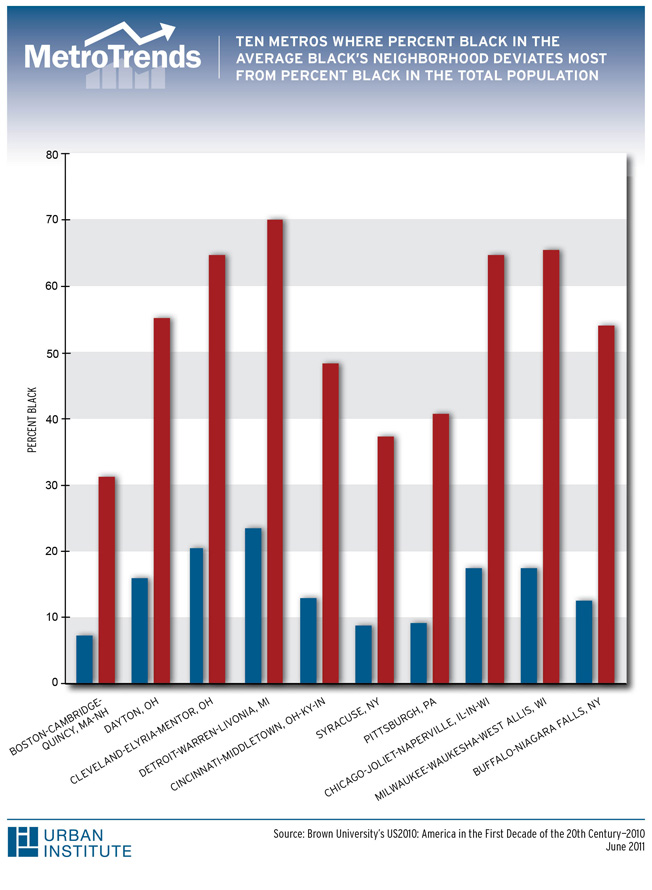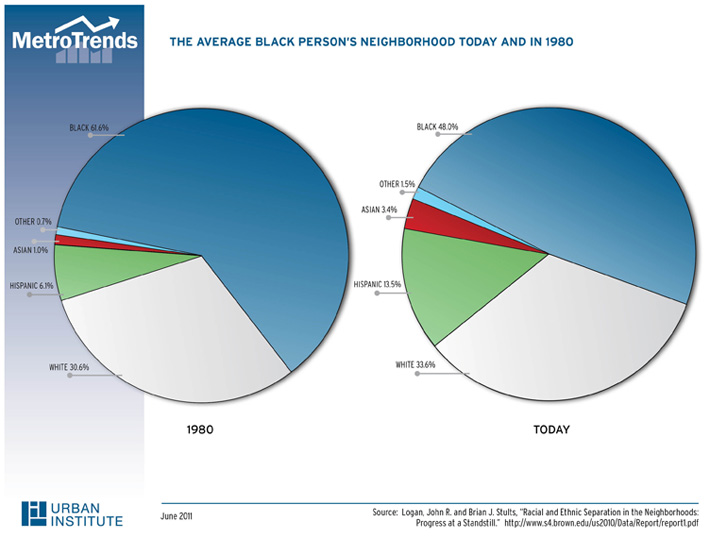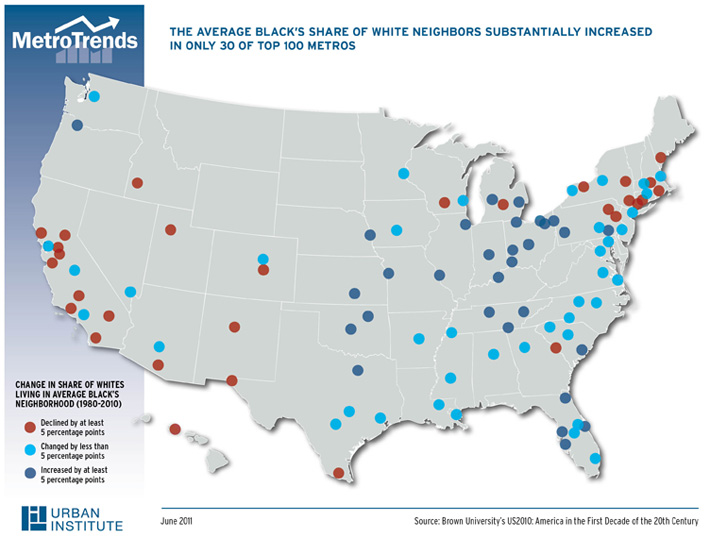
|
|
Neighborhood Diversity Immigration Brings Diversity to Neighborhoods Where African Americans LivePeople interested in understanding patterns of neighborhood segregation in a multi-ethnic nation like ours often focus on the composition of the average white person's neighborhood and how it is changing over time. In an earlier commentary, we discussed this important indicator of neighborhood diversity and how it varies across metro areas nationwide. What about the composition of the average Black person's neighborhood? Historically, racial segregation has excluded African Americans from neighborhoods that offer high quality housing, schools, and other public services and has deprived predominantly Black neighborhoods of essential public services and private investments. Today, even middle-class Black neighborhoods have lower house price appreciation, fewer neighborhood amenities, lower performing schools, and higher crime than white neighborhoods with comparable income levels. Decades of rigorous research have documented how the persistence of residential segregation sustains racial and ethnic inequality in the US -- stunting house price appreciation and hence, wealth accumulation among minority homeowners, undermining school quality and minority educational attainment, limiting employment opportunities and earnings for minority workers, and damaging the health of children and adults. These disparities ultimately hurt all of us (see, for example, Segregation: The Rising Costs for America, edited by James H. Carr and Nandinee K. Kutty, 2008). Evidence suggests that both racial discrimination and residential segregation have slowly declined over the last three decades. Nonetheless, across US metro areas, the average African American now lives in a neighborhood where almost half his neighbors (48 percent) are Black, although the US population is only 12 percent Black. But this picture varies dramatically from one metropolitan area to another. Among the top 100 metros nationwide, the average Black's neighbors range from only 2 percent Black in Boise, Idaho to 70 percent Black in Detroit, Michigan. In 22 of these big metros, this proportion exceeds 50 percent. This group includes six of the 10 biggest metro areas nationwide and seven of the 10 with the largest African American populations. To some extent, the composition of the average Black's neighborhood reflects the composition of the metro area around it. For example, the total population of metropolitan Boise is only 1 percent African American, compared to 24 percent in metropolitan Detroit. But in some metros, the average African American lives in a much more predominantly Black neighborhood than one would expect given the composition of the area as a whole. Seven of the ten metros with the biggest deviations are located in the Rust Belt, where stark patterns of residential segregation were established during the first half of the twentieth century, when large numbers of Blacks migrated from the south to work in manufacturing jobs. Who else lives in the average Black person's neighborhood? In most metros (77 of the top 100 nationwide), a majority of his non-Black neighbors are non-Hispanic whites. In 16 of these metros - all located in either the South or the Midwest - more than 85 percent are non-Hispanic whites. In contrast, in 23 metros - almost all in the West - the average African American lives in a neighborhood where a majority of his non-Black neighbors are Hispanic or Asian. Over the past three decades, the places where Blacks live have become more diverse in most metropolitan areas. Across all metros today, a third of the average black's neighbors are white, 14 percent are Latino, and 3 percent are Asian. In 1980, the average Black (metropolitan) American lived in a neighborhood that was more predominantly black (62 percent), with fewer Latinos and Asians but roughly the same share of whites In 88 of the nation's 100 biggest metros, the average African American's neighborhood is less predominantly Black today than it was in 1980. Changes over this period range from a 36 percentage point drop in the North Port-Bradenton-Sarasota, Fl region to a 7 percent increase in the Madison, WI metro. The biggest declines in the average African American's share of Black neighbors resulted from increases in the share of Hispanic neighbors. For example, in the Las Vegas metro, the average Black person saw a 33 percent drop in the share of Black neighbors, a 25 percent increase in the share of Hispanic neighbors, and essentially no change in the share of white neighbors. At the opposite extreme, for the average African American living in the Madison metro, the share of Blacks in his neighborhood actually rose by 7 percentage points, while the share of Hispanics rose 9 points and the share of whites declined 19 points. In only 30 of the top 100 metros, did the average African American see an increase of more than 5 percentage points in the share of non-Hispanic whites living in his neighborhood. Interestingly, most of these metros are in the Midwest and South; this group also includes six of the ten metros where the share of Blacks in the average Black person?s neighborhood remains unexpectedly high today. In 30 metros, the average African American saw a decline of more than 5 percentage points in the share of white neighbors since 1980. Most of these metros are located in the West where the share of Hispanics in the average Black's neighborhood often rose substantially. The historical record clearly demonstrates that our nation's stark patterns of racial segregation were established through public policy, including the enforcement of restrictive covenants, local land use regulations, underwriting requirements for federally insured mortgage loans, and siting and occupancy restrictions for public housing. But the dynamics that sustain segregation now are far more complex and subtle. In order to create and sustain the racially mixed neighborhoods many Americans would prefer, public policies have to address multiple factors, including racial discrimination, differences in information sources, and differences in income and assets. All data are from Brown University's US2010: America in the First Decade of the 20th Century, a project dedicated to changes in American society in the recent past. Estimates of racial composition today derive from the 2005-2009 tract-level American Community Survey data, which are subject to sampling error and may be imprecise in small areas. |
Experts Feedback
Send us your comments to help further the discussion. Share
Commentaries
|








 Margery Austin Turner
Margery Austin Turner Zachary McDade
Zachary McDade